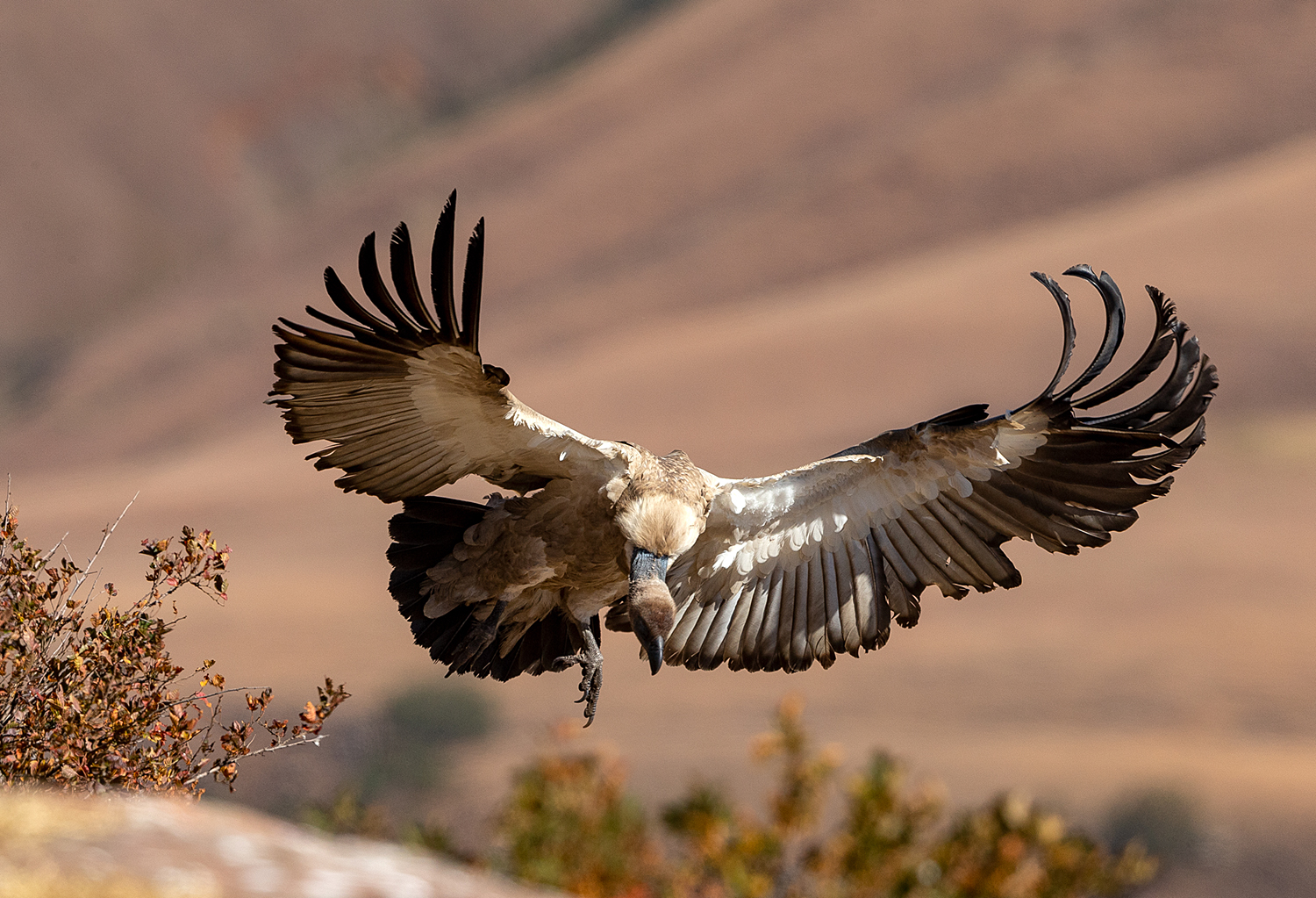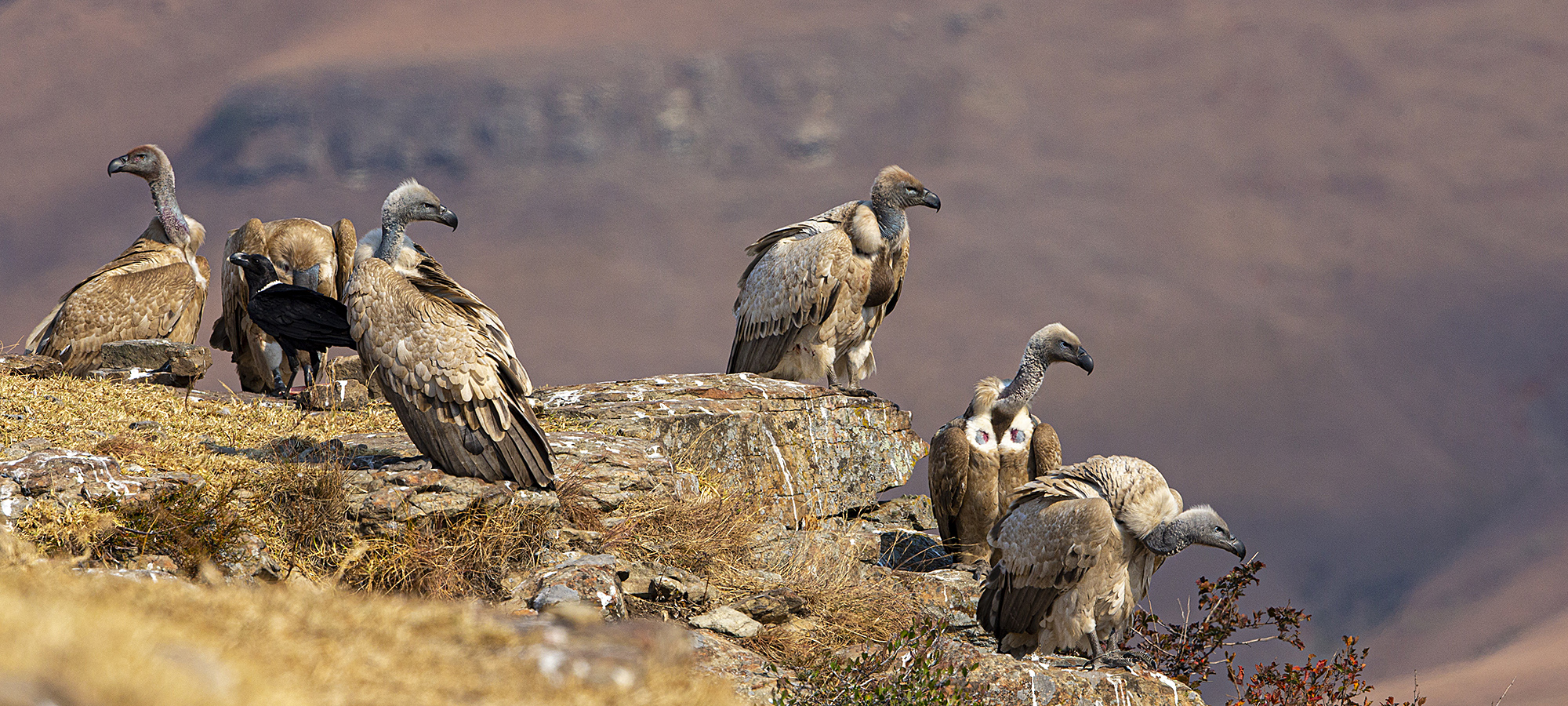Misunderstood Species
Misunderstood Species by Rosamund Macfarlane
Photographer and Bird Photographer of the Year entrant Rosamund Macfarlane explores the myths behind the Bearded Vulture Gypaetus barbatus and shares her own experience of the species in the Drakensburg Mountains of South Africa.
Rosamund Macfarlane ©John Macfarlane
The misunderstanding may have started with the father of Greek Tragedy, Aeschylus, being killed in the 5th century BC by a tortoise being dropped on his bald pate by an “eagle”. This was almost certainly a Bearded Vulture (Gypaetus barbatus) hoping to shatter it on a rock. The misconception was perpetuated as two centuries ago in Southern Europe they were called “lammergeiers”, the perception being that they killed lambs, because bones had been found in their stomachs. The birds were persecuted and the last Alpine specimen was killed in 1913. Bearded vultures are actually fairly docile by nature, do not hunt live prey and in any case their talons are too weak to catch lambs. Their diet is almost exclusively bone marrow: they either swallow small bones or drop larger ones up to 4kg in weight (even the occasional tortoise!) onto rocks from a height of up to 150 metres. Their strongly acidic stomach contents allow them to dissolve bones within 24 hours. They do need some meat in the breeding season to feed to their chicks, which they obtain from carrion.
I had previously seen these ossiphrages (bone-breakers) in Ethiopia, but only from a distance. After looking at pictures of them on the internet taken at eye level I knew I badly wanted to photograph them like this. We booked the “old” vulture hide in Giants Castle Nature Reserve in South Africa at a very reasonable cost over a year in advance (just for the 2 of us although it will comfortably fit 3 with reasonable sightlines), and also very adequate self-catering accommodation within the park (beware thieving Chacma baboons!). We hired a car from Johannesburg and drove through KwaZulu Natal to the glorious Drakensburg mountains.
Old Vulture Hide, Giants Castle Nature Reserve. ©Rosamund Macfarlane
We left from camp headquarters before dawn and were driven by Mbeki up the escarpment (4WD essential but you can book a lift through the park) to the beautifully camouflaged hide, perched like an eyrie at the top of a cliff, accompanied by a couple of very smelly, very heavy buckets of bones! These we laid out at a distance of about 30 metres – it is advisable to wedge them with stones to try to prevent the white-necked ravens rolling them off the cliff. We used beanbags in the hide, Canon 100-400mm lenses with extenders and a 500 mm prime (a better option), which we shared -- with some difficulty!! We waited as a magenta dawn coloured the escarpment, and long swathes of mist wreathed around the brown velvet foothills.
Putting out fat and bone fragments. ©Rosamund Macfarlane
The birds are used to finding bones at this site and it is vital to supplement the ever decreasing supply of food for scavengers. The extra fat and bone fragments supplied assist increased survival, especially during the first year of life. Feeding sites also allow provision of food free of poisonous agro-chemicals and the veterinary drug Diclofenac, used for treating arthritis in cattle. This drug causes fatal kidney failure in vultures that consume an animal carcass containing the drug – and it is one cause for the 99% decline in vulture numbers in Asia.
A Bearded Vulture photographed from above. This image was an entry into the 2019 Bird Photographer of the Year Competition and caught the Judges’ eyes in the Birds in Flight category. ©Rosamund Macfarlane
It was not long before the flapless glide-past of these magnificent birds started, allowing a close appreciation of their beauty. An adult male gave us the once over in a sideways glance, gorgeous with his pewter wings, scarlet eye rings, a wedge-shaped tail that allows for remarkable manoeverability, and of course the black eyestripe that runs into black bristles at the base of their beak and looks so much like a beard. Their orange/gold chest and leg feathers are so coloured because of the iron-rich dust in which they take their baths. Juveniles are less glamorous but are almost equally impressive in their wing span.
Becoming familiar with their circular flight path made it easier to anticipate from where the next bird would arrive, but inevitably, when the dominant male did land, he unexpectedly came up from below. We were thrilled to see him (a far from guaranteed sighting) strutting his stuff, even if he did not fly away with a bone and drop it.
A Bearded Vulture and Raven. ©Rosamund Macfarlane
On an adjacent cliff face to that occupied by this isolated colony of bearded vultures (300-350 birds) in the Drakensburg lives a colony of Cape Vultures (Gyps coprotheres), another Old World Vulture (they find their food by eyesight alone). The species was accorded an “Endangered” status in 2017.
Cape Vulture coming in to land. ©Rosamund Macfarlane
Several of them arrived in a “kettle” – the collective term for vultures in flight -- and as they approached they appeared positively angelic, clad in soft, creamy plumage and with wings outstretched to about 2.5 metres -- until one focused on their heads. Their massive beaks were attached to a small head at the end of half a metre of blue, serpentine neck. This unfeathered neck of course ensures a greater degree of cleanliness when penetrating the innards of a carcass. (Because of the different feeding method of the bearded vulture, its neck is feathered.) The prominent bare skin patches on their chests are thought to be temperature sensors to help with detecting thermals. They sat occasionally pecking at their neighbours or aiming a vicious jab at the irritating ravens. Alas, they did not settle but, as if on command, rose into the air, wheeled and flew away across the valley. However, we felt we had been treated to a special viewing of this rare bird.
A committee of Cape Vultures. ©Rosamund Macfarlane
A Bearded Vulture - majestic in the magenta dawn. ©Rosamund Macfarlane
The litany of threats to large birds is alas becoming increasingly familiar to us: loss of habitat; electrocutions from collisions with power lines; human ignorance about perceived risks to livestock; lead poisoning as a result of feeding on carcasses that have been shot. Poachers are known to deliberately poison carcasses to kill vultures circling above the carrion, which might otherwise expose their activities to rangers – 537 vultures died near 3 elephant carcasses in Botswana in June 2019.
Awareness of the critical and very efficient ecosystem services provided by vultures in restricting the spread of disease is growing in the African continent: let us hope this is not too late in the day. There is also exciting conservation work being done by the Vulture Conservation Foundation reintroducing bearded vultures in the Alps, with support from politicians, hunters and farmers (www.4vultures.org).
Rosamund Macfarlane, July 2019.








